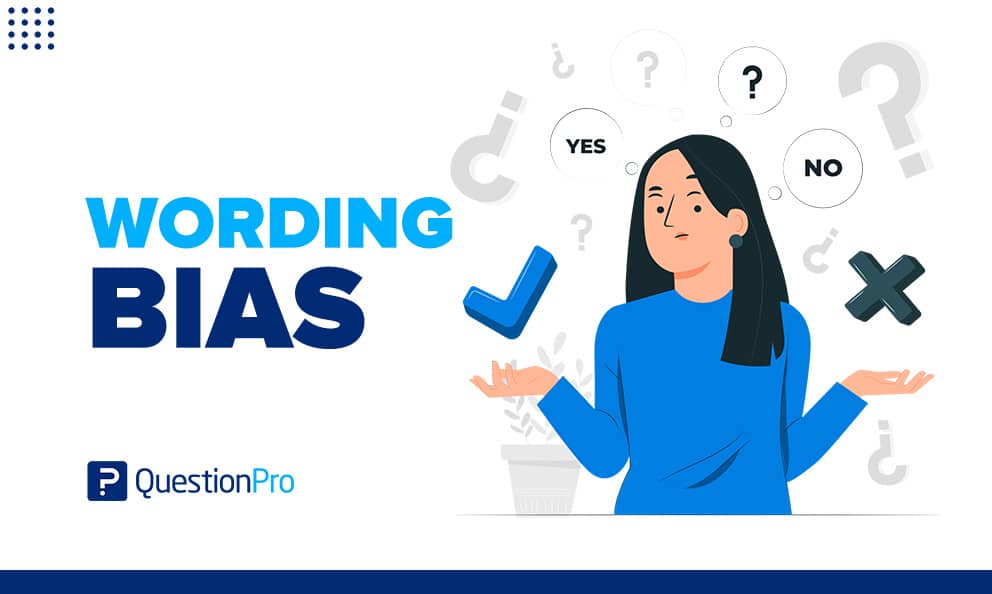 Reading Time: 3 minutes read
Reading Time: 3 minutes readWhen designing your questionnaire, many things can go wrong if we ignore the details. This can mean that our research returns incorrect data and invalidates our study.
In this article, we will talk about wording bias, and we will explain everything you need to know about one of the most common research biases and some tips to avoid it.
What is wording bias?
Wording bias, also called question-wording bias, happens in a survey when the wording of a question systematically influences the responses. Wording bias leads to survey data becoming less valuable as it is inaccurate.
A survey question is biased if it is phrased or formatted in a way that prepossesses people towards a specific answer. Also, if the survey questions are hard to understand, it is difficult for customers to answer honestly.
Example of Wording Bias
Wording Bias can be caused in various ways, all related to how the interviewer or the team formulates their questions and answer options, below, we share some of the most common cases and some examples so you can identify them.
Let’s say your questionnaire contains the following question:
Are you in favor of building a shopping center that could increase traffic in the area?
YES | NO
In the example above, we include additional information likely to influence people’s perceptions and how they tend to answer that question. As you can see, information about the possible adverse effect of the construction in the area is included, so the response trend would surely lean NO.
If the question were:
Are you in favor of constructing a shopping center that will provide employment to more than 20 families in the area?
YES | NO
We can distinguish that information that influences the respondent’s perception is also included. On this occasion, the trend is undoubtedly inclined to YES. However, this does not mean that it is correct since there is still a bias, and for the validity of any study, it is always desirable to seek neutrality in the opinion of the people surveyed, so in this example:
Are you in favor of constructing a new mall in the area?
YES | NO
It would be a slightly better-posed question since unnecessary and biased information is eliminated.
This was just one example of how the way the question is formulated can impact the study results.
However, there are other ways to cause wording bias, either by altering the instructions on how to answer the survey or how you formulate the answer options.
How can I reduce wording bias?
When you create a survey, the order of both questions and answer options in your survey matters. Questions that come early in your survey might impact how respondents respond to questions later in your study.
Here are some tips to avoid making these mistakes when creating your questionnaire.
Short and clear questions and answers
Keep your questions short and precise. Ask neutrally worded questions. Your question shouldn’t have too much information, and it shouldn’t have too little. It should be just right. Respondents are less likely to answer if the question is too long. Or if they do not understand the question.
Leading questions
Avoid leading questions. Instead of asking a leading question like “Are you satisfied with our service?” you can ask about the quality of service provided.
Simple Answers
If answer options are long and unfamiliar, the respondent may face difficulties answering the questions.
One technique to ask a question precisely is to use a matrix question with multiple answer choices.
Carry out a pilot survey
Before launching your questionnaire to your entire database or sending a whole fleet of interviewers throughout the city, we recommend that you do a small test where you include control and feedback questions to identify areas for improvement and if the questionnaire does not have any type of bias or error that could compromise the integrity of the study.
Are you ready to lunch your first survey?
We hope that these tips will help you when designing your survey and conducting your research. We remind you that at QuestionPro, we have all the types of questions necessary to design an ideal questionnaire for your projects.
In addition, our analysis module will allow you to see the results in real-time to identify any anomaly or manage your information to avoid including biased data or data that is not of value for the study.




















